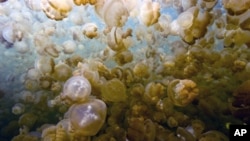Those jellyfish you see seemingly floating and bobbing along with the waves have a secret.
New research shows the gelatinous creatures are among the best swimmers in the ocean, which could be an important reason they have been so successful as a species.
“We find that jellyfish exhibit a unique mechanism of passive energy recapture, which can reduce metabolic energy demand by swimming muscles,” write the researchers in the journal Proceedings of the National Academy of Sciences. “Contrary to prevailing views, this contributes to jellyfish being one of the most energetically efficient propulsors on the planet.”
Researchers said the results show why medusan swimmers – a name given to creatures like jellyfish that resemble Medusa of Greek mythology – thrive despite their simple body plan. They added that the research could have implications for bio-inspired design, where low-energy propulsion is required. Previous theories about the success of jellyfish assumed the creatures were able to adapt to changing water temperatures and take advantage of a decline in other potential predators due to overfishing.
Brad J. Gemmell at the Marine Biological Laboratory at Woods Hole in Massachusetts and a team of other researchers studied the movement of jellyfish with funding from the U.S. Navy, which had expressed interest in non-traditional propulsion.
The key to Gemmell’s findings lies with the jellyfish’s second thrust when moving. Scientist have long known jellyfish move by squeezing water through the bell that forms ahead of their body. Scientists have also understood that jellyfish derive some forward momentum when the bell refills with water, but until now, it hadn’t been understood how much propulsion this secondary thrust generates.
As it turns out, the second thrust accounts for 32 percent of the jellyfish’s forward movement, and the kicker is it requires no energy. It’s a purely mechanical movement, like a rubber band snapping back after being stretched.
The findings could lead to more efficient underwater robots that could ostensibly prowl the seas for years, sending back data.
Here's a video showing the propulsion derived from the jellyfish's secondary thrust:
(Video: Proceedings of the National Academy of Sciences)
In the first part of the video, an A. aurita jellyfish shows the velocity vectors and vorticity produced by swimming. Notice how the stopping vortex forms upstream and on the exumbrellar surface of the animal before recovery. The vortex ring then moves under the bell as its vorticity (energy) increases. The second part of the video shows instantaneous pressure field estimations along with body velocity to demonstrate a mechanistic explanation for how jellyfish can accelerate, and thus gain extra distance during a period of the swimming cycle in which there is no kinematic motion.
New research shows the gelatinous creatures are among the best swimmers in the ocean, which could be an important reason they have been so successful as a species.
“We find that jellyfish exhibit a unique mechanism of passive energy recapture, which can reduce metabolic energy demand by swimming muscles,” write the researchers in the journal Proceedings of the National Academy of Sciences. “Contrary to prevailing views, this contributes to jellyfish being one of the most energetically efficient propulsors on the planet.”
Researchers said the results show why medusan swimmers – a name given to creatures like jellyfish that resemble Medusa of Greek mythology – thrive despite their simple body plan. They added that the research could have implications for bio-inspired design, where low-energy propulsion is required. Previous theories about the success of jellyfish assumed the creatures were able to adapt to changing water temperatures and take advantage of a decline in other potential predators due to overfishing.
Brad J. Gemmell at the Marine Biological Laboratory at Woods Hole in Massachusetts and a team of other researchers studied the movement of jellyfish with funding from the U.S. Navy, which had expressed interest in non-traditional propulsion.
The key to Gemmell’s findings lies with the jellyfish’s second thrust when moving. Scientist have long known jellyfish move by squeezing water through the bell that forms ahead of their body. Scientists have also understood that jellyfish derive some forward momentum when the bell refills with water, but until now, it hadn’t been understood how much propulsion this secondary thrust generates.
As it turns out, the second thrust accounts for 32 percent of the jellyfish’s forward movement, and the kicker is it requires no energy. It’s a purely mechanical movement, like a rubber band snapping back after being stretched.
The findings could lead to more efficient underwater robots that could ostensibly prowl the seas for years, sending back data.
Here's a video showing the propulsion derived from the jellyfish's secondary thrust:
(Video: Proceedings of the National Academy of Sciences)
In the first part of the video, an A. aurita jellyfish shows the velocity vectors and vorticity produced by swimming. Notice how the stopping vortex forms upstream and on the exumbrellar surface of the animal before recovery. The vortex ring then moves under the bell as its vorticity (energy) increases. The second part of the video shows instantaneous pressure field estimations along with body velocity to demonstrate a mechanistic explanation for how jellyfish can accelerate, and thus gain extra distance during a period of the swimming cycle in which there is no kinematic motion.
Instantaneous pressure field estimations are shown simultaneously with body velocity to demonstrate a mechanistic explanation for how jellyfish can accelerate, and thus gain extra distance, during a period of the swimming cycle in which there is no kinematic motion.
Read more at: http://phys.org/news/2013-10-reveals-jellyfish-efficient-swimmers-video.html#jCp
Read more at: http://phys.org/news/2013-10-reveals-jellyfish-efficient-swimmers-video.html#jCp










